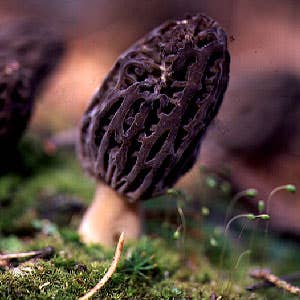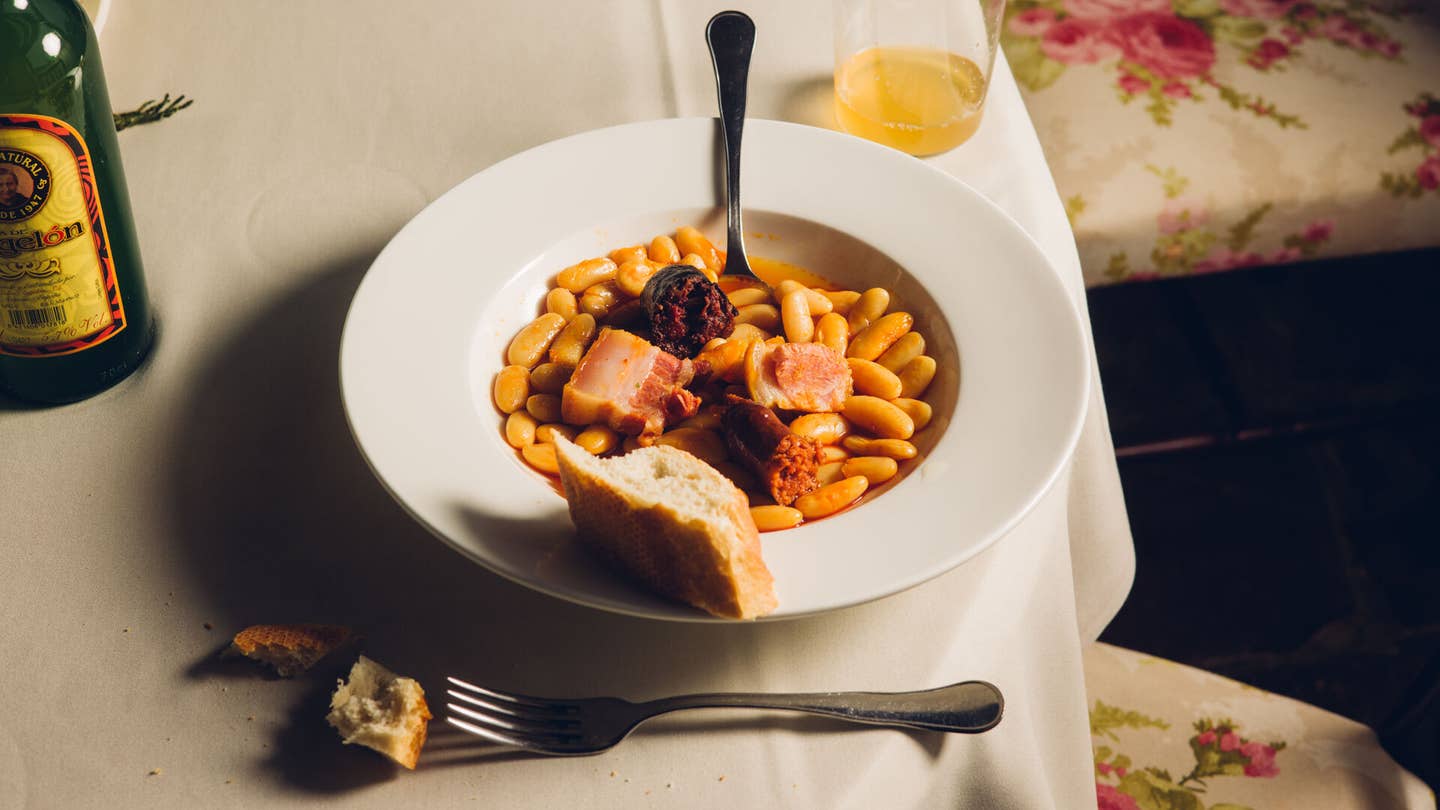
The Morelist
A chef forages in the Minnesota woods for the rare, delicious morel mushroom—and discovers its connection to his life.
My father taught me to hunt morel mushrooms more than 35 years ago, and I have cooked with them, as a professional chef, for over 24 years. Yet every spring, I become the apprentice once again: Locating these elusive and highly prized fungi is an inexact science at best, and developing new recipes that complement the subtle, smoky flavor of fresh morels—which somehow reminds me of eggplant, or chicken-fried steak, or both at once—is always a rewarding challenge.
Last summer, in a world where bones, antlers, and claws are currency—my world, that is, centered in Ely, Minnesota, 17 miles from the Canadian border—I bribed my friend Andy Davis (who has spent the last year researching morels around the country) with a bear skull to guide us on a morel-hunting foray. Like fishermen, morel hunters are born honest, but they get over it. Like fishermen, they do not readily share their secret places. And like fishermen, who could just as easily go to the nearest supermarket to purchase far more cheaply (in cost, inconvenience, and danger) what they choose to hunt, they enjoy the intense emotional satisfaction of acquiring food in nature.
This particular outing was a reckless deviation from morel orthodoxy. Morels—black (Morchella elata) and yellow (Morchella esculenta)—are among the first mushrooms to appear in spring, growing in April and May. The season traditionally begins when the lilacs bloom. But it was already late June, it seemed too hot, and the winter had been far too dry. I was almost positive we'd missed our chance for prime harvesting. Andy, however, was so thoroughly convinced that the mushrooms could still be found that I couldn't resist the opportunity to hunt for them.
Four of us—photographer Per Breiehagen, landscape artist Brent Spink, my 11-year-old daughter Lauren, and myself—set off with Andy, portaging canoes about a mile and a half to Gabbro Lake. Under conditions that pilots refer to as "severe clear", we put in and paddled across the lake to an area that had been ravaged by forest fires the previous year. (It is a curiosity of morels that their preferred habitats include burned-over areas, as well as coniferous woods and, for some reason, old apple orchards.) As the canoes glided silently across the lake, the aroma of charred earth grew steadily stronger. Covering the ground, and most of the fallen red and white pines, was a thick blanket of young foliage. The green regrowth of forbs and shrubs against the ebon pines was simply, serenely beautiful.
We landed on an unnamed island, and when we were only minutes out of our canoes, Andy called us over to a small clump of morels he had already spotted. We just stared, acclimating our vision to the camouflage of the mushrooms in their environment—black caps against the dark earth. But the black morel, with its involuted, honeycombed surface and white stalk, has a very distinctive appearance, which ultimately makes it relatively easy (and safe) to identify. Andy bent over and cut one stem at a time with a small knife, being careful not to pull the mushrooms out by hand—which could damage the mycelium, the morel's fragile, spiderweb-like root system. (While not all experts agree, I believe that leaving the mycelium intact allows more morels to grow back.) As Andy harvested the mushrooms, he dropped them into a flat-bottomed wicker basket to protect the delicate fungi.
Leaving Per to his equipment, the rest of us scattered to find our own precious caches. Lauren and I hunted together, heading for the tip of the island, where we found a few more morels scattered about. Then, with a gambler's addiction, we tenaciously scoured the island's hills and valleys for miles, looking for that one big score. But though we hunted for several hours, our morel bonanza never materialized. Had the spring rains come a week or two earlier, we speculated, this would have been a commercial-grade harvest.
Andy and Brent wanted to push on farther down the lake to investigate some other sites that looked promising. But, lulled by the allure of the setting, Lauren and I stayed behind and spent the rest of the afternoon skipping rocks, wading in the iron-tinted water, and napping in the hot summer sun. We had found some morels, which was a bonus, but that was only a small part of the whole. I've learned that most people who hunt morels, impractical optimists that they are, find something deeply moving, almost supernal, about the experience—whether they happen upon a treasure trove of the mushrooms or not. Someone once asked the avant-garde composer and avid mycologist John Cage about looking for morels in summer, after the high season was ended, and he answered somewhat gnomically, "Go into the woods tomorrow and look. And if you don't find any, don't worry." It was in that Zenlike spirit that I spent just another day in paradise with my daughter, breathing deeply of that yet sweet and lucid air.
The use of mushrooms as food predates written history. Traces of puffballs have been uncovered in Stone Age settlements. The ancient Greeks believed that mushrooms came from Zeus's lightning because they inexplicably appeared after rains. In the Middle Ages, the circular patterns formed by some mushrooms, christened "fairy rings", were thought to be the work of the "little people", who supposedly danced around them at midnight, performing magic rituals.
Many varieties of wild mushrooms are highly prized today—mysterious black trumpets, lovely yellow chanterelles, meaty ceps, delicious milk caps—but, along with truffles, morels are the royalty of fungi, inspiring true obsession among both gastronomes and gatherers. Europeans have long appreciated their savory attractions, incorporating morels in myriad ways: serving them with lobsters or with crayfish and truffles, with spring vegetables like asparagus, and in such classic dishes as morels in cream sauce. Among the many mushroom dishes in Apicius's book of recipes, compiled during imperial Roman times and considered the oldest European cookbook, are three with morels. France's Louis XIII so loved their earthy scent that he would thread morels and hang them in his bedroom to dry, an activity that reportedly occupied him on his deathbed. In Germany, laws had to be passed forbidding the burning over of wooded land for the encouragement of morels.
Here in the United States, the morel has become a sort of talisman among mushroom hunters. Although they can be found throughout North America, morels are very prolific in the Midwest, where they are a regional passion. At the Peoples State Bank of Chandlerville, Illinois, for example, an image of three morels is embossed on the letterhead, checks, and deposit slips. In 1984, Minnesota designated the morel its official state mushroom. Michigan, meanwhile, has long considered itself the Morel Capital of the World, and if any Michiganders are upset over Minnesota's bit of legislative one-upmanship, they may be consoled by the fact that their own Boyne City is host to the National Mushroom Festival, held annually on Mother's Day weekend. The festival's morel-hunting contest draws hundreds of competitors, who collect as many of the elusive fungi as they can in 90 minutes (the record, set in 1984, is 986 morels). Boyne City's and the other Michigan mushroom festivals, in Harriston, Lewiston, and Mesick, traditionally have a carnival atmosphere, and, in the case of the Mesick event, the crowning of a Mushroom Queen.
Another gauge of morels' cultural and culinary importance (and, indeed, of their scarcity) is their cost—which can range up to $24 a pound for fresh ones in season and $125 per pound for dried. Morels have recently become more easily available, as techniques for cultivating them have been developed. The price of cultivated morels—which are not as strongly flavored—is somewhat lower.
Meeting back at our canoes, we examined our take. We'd ended up gathering only about sixty morels, both black and yellow. But there were consolations: On our paddle back, we saw a bald eagle, turkey buzzards, and beaver. And there, on the shore of the bay, as we approached the portage, was a young buck, his antlers thick with velvet, which would soon be rubbed off to expose polished tines.
We returned to Brent's cabin, a beautiful log house overlooking Shagawa Lake that he and his brothers had built by hand, and cleaned our meager harvest. Then Lauren dipped the morels in an egg wash and dredged them in seasoned flour, and we fried them in sweet cream butter by the warm glow of oil lamps. The smell of the entire North Woods seemed to waft from the skillet. We made a salad and cut slices from a fat loaf of country bread. Brent gathered wildflowers and set them on a picnic table in the yard. Then we sat down, and with glasses of Summit Hefe Weisse beer from St. Paul, Minnesota, we toasted our friendship and the bounties of harvests we have not sown.
In the fading light, I thought back to the afternoon, to walking through the woods with Lauren—and it suddenly occurred to me that it is the morel that connects me with a child's faith, and with the future. When I was growing up, the only time I had my father to myself was when we went morel hunting, driving down the soft back roads of Iowa, through the brooding darkness and steely morning mist, looking for stands of dead elms or apple trees. Lauren was born in the middle of morel season, and the same power that brought my father and me together also brings my daughter closer to me. We've hunted morels alone, together, in the dew-washed architecture of spring. Here is the hidden soul of harmony.
Keep Reading
Continue to Next Story










